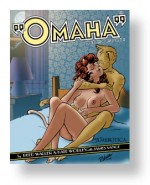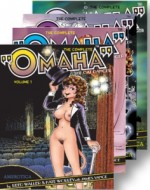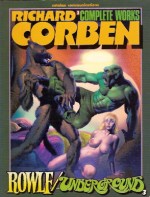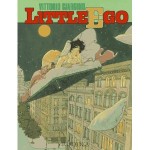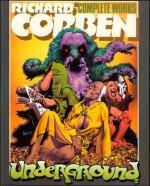
By Reed Waller & Kate Worley with James M. Vance (NBM/Amerotic)
Set ISBN: 978-1-56163-601-3
Vol. 1 ISBN: 978-1-56163-451-4, vol. 2 ISBN: 978-1-56163-457-3, vol. 3 ISBN: 978-1-56163-474-3
These books are intended to make adults laugh and think and occasionally feel frisky. If the cover images haven’t clued you in, please be warned that these items contain nudity, images of sexual intimacy – both hetero and homosexual – and language commonly used in the privacy of the bedroom and probably school playgrounds whenever supervising adults aren’t present.
If that sort of thing offends you, read no further and don’t buy these books. The rest of us will just enjoy one of the best graphic novel experiences ever created without you.
Omaha the Cat Dancer began during the 1970s as an “underground†venture and over the torturous decades grew into a brilliant but controversial drama of human fallibility with all the characters played by funny animals. What most people noticed was the matter-of-fact and constant inclusion of graphic sex acts.
The series was subject to many obscenity seizures by various muddle-headed stickybeaks over the years, inspiring the formation of the Comic Book Legal Defense Fund. One classic case apparently involved the local defenders of morality raiding a comics store because Omaha promoted Bestiality!
As there’s only so much excitement a man of my advanced years and proclivities can endure (and probably only so much me you can stand) I’ll be to reviewing these seven tomes in two batches rather than in totality but I will remind you each time that the whole saucy saga is available in a supremely economical shrink-wrapped gift set that you’d be crazy to not take advantage of.
After an introduction by late-coming co-scripter James Vance and Reed Waller’s original intro from the 1987 collected edition, The Complete Omaha the Cat Dancer volume 1 gathers the short story appearances from a number of Counter-culture Commix as well as some out-of-continuity infilling short pieces so readers can enjoy what can best be described as the official Directors Cut of the tale.
The wicked wonderment begins with the very first ‘Adventures of Omaha’ from Vootie in 1978. Vootie began in 1976 as a self-published fanzine founded by Reed Waller and like-minded artistic friends who bemoaned the loss of anthropomorphic comics – once a mainstay of US comicbooks.
When contributors also griped that there wasn’t much sex in comics either, Waller, taking inspiration from R. Crumb’s Fritz the Cat and responding to an intensification of local Blue Laws, created the evocative, erotic dancer and compared her free and easy life-style against a typical, un-elected, interfering know-it-all moral guardian busybody. Blue Laws are particularly odious anti-fun statutes – usually instigated by religious factions – designed to keep the Sabbath holy by dictating shop-opening hours and generally limit or ban adult entertainments like clubs and pubs, and their repressive use (in fact and fiction) became a major narrative engine for the series.
‘Why they Call Her Omaha’ introduces young stripper Susie Jensen who hits the metropolis of Mipple City, Minnesota (a thinly concealed Minneapolis) and signs up with a modelling agency where she meets fellow dancer Shelley Hine. Over lunch they bond and pick a better stage name for the gorgeous but naive newcomer, whilst ‘Kitten of the Month’ and ‘Omaha centrefold’ reveal the first glorious results of her managements efforts. No-holds barred sexual action returns in ‘Shelley and Omaha’ with the girls, now popular erotic dancers, meeting some guys who will play a big part in the unfolding drama to come.
In ‘Chuck and Omaha’, which officially heralded the beginning of scripter Kate Worley’s stunning contribution to the series, Jerry – one those aforementioned pick-up guys – introduces Omaha to Chuck Katt, a shy artist who will become the great love of the sexy kitty’s life. ‘Adventures of Omaha’ sees the budding relationship progress whilst ‘Tip of the Iceberg’ moves the grander story arc along when Mipple bans nipples in the opening shot of a political power-grab using Christian and Family-morality pressure groups as unwitting, if fervent, patsies…
Although it comprises less than 50 pages the preceding material took nearly fifteen years to produce. For years Omaha had no fixed abode; peripatetically wandering from magazine to Indie book and even guest-shots in the occasional mainstream publication. From Kitchen Sink’s Bizarre Sex #9-10 in 1981-2, a pastiche page in E-Man (in 1983 and included in volume 2), Dope Comix #5 (1984), she even starred in a story from Munden’s Bar Annual #2 in 1991. Often stalled for creative, not censorship, reasons Omaha finally won her own title in 1984 from SteelDragon Press, but vanished again until 1986 when Kitchen Sink Press finally took over publication. For further details I strongly advise checking the lovely official website at www.omahathecatdancer.com.
Volume 1 switches to high gear and addictive narrative mode with the 40 page ‘Omaha #0’: a single page recap followed by a powerfully compelling yarn wherein the forces of decency make life increasingly difficult for the adult entertainment industry. With stripper bars closing Omaha is recruited to dance for “The Undergroundâ€: an exclusive, ultra-secret, high-class bordello that caters to the darkest desires of America’s ultra-elite of: businessmen and politicians many of whom are actively leading the Decency campaign…
Shelley is involved too, recruiting contacts from her old profession for more hands-on roles. Meanwhile Chuck has reapplied for his old advertising job where his old girlfriend Joanne makes life uncomfortable. However she has other problems as powerful forces are drawing Omaha and Chuck into a far-reaching and sinister scheme…
On opening night all the elements for disaster converge as the “Movers and Shakers†get more debauchery than even they can handle: someone has doped the entire proceedings leading to a violent, destructive orgy and set up cameras to record the whole event for blackmail purposes. As they flee the club hitmen try to kill Chuck but shoot Shelley instead. Believing her dead, Omaha and Chuck run for their lives. Heading for Joanne’s house Chuck reveals that he is the son of Charles Tabey: monomaniacal millionaire businessman, undisputed ruler of Mipple City and the probable target of the assassination…
Narrowly escaping another murder attempt they find Tabey and Joanne are intimately involved and are horrified to find that the millionaire was behind the whole thing, intending to mould Chuck into the kind of son he needs. The man is also clearly raving mad…
The traumatised, terrified young lovers jump into their car and head for California in the short ‘Adventures of Omaha’ vignette and the first volume concludes with the contents of ‘Omaha #1‘ as they reach San Francisco tired, hungry and broke.
Grateful for the kindness of strangers, they soon discover Joanne waiting for them and find that Tabey is not their only persecutor. During a drunken three-way another hired killer almost ends them all…
From a well-intentioned, joyous celebration of open living free-loving modernity Omaha had evolved into a captivating adult soap opera and conspiracy thriller of mesmerising intensity and complexity…
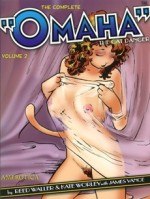
Volume 2, with a reprinted introduction by Kate Worley, eases into the enticing adult entertainment with the aforementioned ‘Hotziss Twonkies’ parody from First Comics’ E-Man #5 before issues #2-5 enlarge the sinister saga. In the aftermath of their latest close shave, Chuck and Joanne antagonistically spar whilst the increasingly traumatised cat dancer wanders the streets of San Francisco. When she is abducted by Tabey, who is moving against all his old enemies, Chuck and Joanne fall into bed…
Meanwhile Jerry, who also works for Tabey, is busying sorting the fallout from the club riot and shooting. In a secluded palatial beach-house Omaha discovers that Chuck’s dad has been watching over them for some time and soon discovers another shocking secret….
Omaha was utterly groundbreaking in its mature treatment of gay and disabled relationships; offering the sound and common sense opinion that this is what all people think and do and after all, “it’s just sexâ€â€¦
Paralysed but not deceased Shelley is also sequestered in the house. She is a long-term Tabey employee and slowly developing a relationship with her nurse Kurt Huddle, and the manic tycoon has convinced Omaha to stay and help care for her. Back in Frisco Chuck has rekindled his old relationship with Joanne, utterly unaware that she has the films and photos taken at the club on that terrible night.
Rob Shaw, gay photographer, enters the picture, as developer and guardian of the contentious materials and old friend of Joanne. Chuck misses Omaha and the tension leads to him splitting with Joanne and moving in with Rob. The cat dancer too is lonely and finds unsatisfactory solace with Jerry again, but when Tabey goes off his meds Jerry arranges for Chuck and Omaha to reunite, leading to a dreadful confrontation between father and long-estranged son, as an apparent result of which the millionaire takes his own life…
Together again at last, Omaha and Chuck comfort each other as the repercussions of Charles Tabey Sr.’s demise shake the country and the cast. The close-knit group endure loss, guilt and outrageous press scrutiny as the matter of inheritance crops up. Against his wishes, Chuck might be incredibly rich and saddled with unwanted responsibilities but there are some unspecified problems with the will.
The plots thicken when Joanne and Rob have a falling out and as all this is going on, back in Mipple City a powerful new threat makes his move. Senator Bonner was one of the patrons at the Underground that fateful night but now he’s making a move for total power, stirring up a wave of fundamentalist hatred and anti-smut indignation with his “Crusade for Decencyâ€â€¦
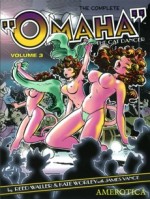
Volume 3 (covering issues #6-9 and with an introduction by Trina Robbins) follows the action back to Minnesota, but things are difficult for Chuck and Omaha who can’t seem to re-establish their earlier, innocent rapport. They go house-hunting, whilst in San Francisco Rob Shaw is visited by thugs after the photos of the riot at The Underground. His shop destroyed, the photographer narrowly escapes burning with it…
Mipple City’s Blue Laws are more draconian than ever. When Omaha and Shelley, who has moved into the ground floor of the Cat dancer’s new house, visit their old workplace the Kitty Korner, they discovers that the performers now have to dance behind plate glass – which makes tucking punter’s tips into g-strings really tricky…
When old friend Shawn turns up he tells Chuck and Omaha of the plan to redevelop A Block – that part of town where all the artists, musicians and strip clubs are. Something needs to be done to stop it – and now, Chuck might just be the richest, most influential degenerate in town…
As the lovers go furniture shopping Shelley and Kurt look for a suitable physical therapy clinic – preferably a non-religious, non-judgemental un-condescending one – and later whilst Omaha helps Shelley move in, Chuck and Jerry make plans to fight the destruction of A Block, but as ever, there is far more going on than the lovers can imagine…
Omaha wants to get back into dancing and as Chuck becomes increasingly mired in the running of his father’s many businesses, Kurt learns some of Shelley’s murky history and Joanne and Jerry compare notes and make plans.
Rob turns up in Mipple after more attempts on his life, convinced that he needs to find his attackers’ boss before his luck runs out and the book ends on a shocking note for Chuck when he discovers that long-dead mother isn’t…
All these volumes, printed in black and white and at 8½ inches by 11, much larger than the original comicbooks, also contain many full page illustrations (many from the delightful art-book The Erotic Art of Reed Waller). This saga is one of the turning points of comics history – a moment when we could all provably say “this is socially relevant, capital “A†Art†– as viable and important as the best play or film or symphony: don’t miss this opportunity to make the whole marvellous classic yours forever…
© 1978, 1981, 1982, 1984, 1985, 1986, 1987-1996 Reed Waller & Kate Worley. Contents of these editions © 2005-2007 NBM. All Rights Reserved








